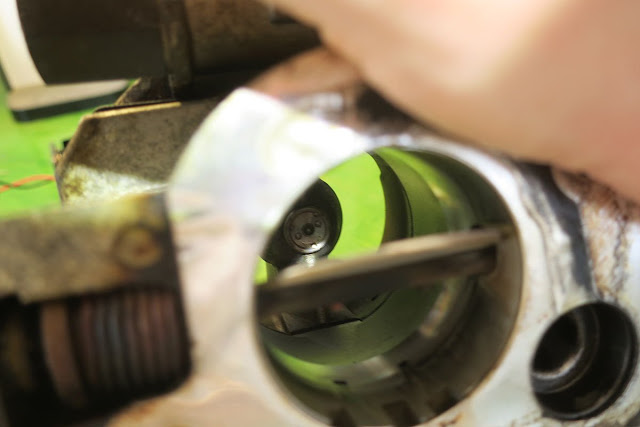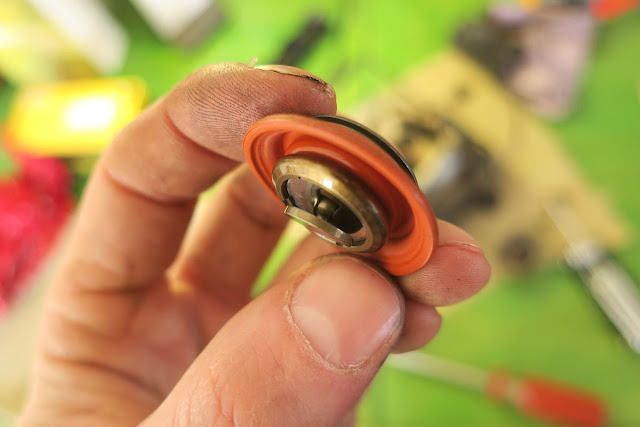My 1990 Olds Cutlass Ciera with a GM TBI 2.5 L I4 Iron Duke would periodically not restart after it had run for a while and was hot. The situation reached peak hilarity when it failed in my carpooling coworkers driveway on a cold morning.
The initial attempt at troubleshooting focused on the TBI unit and fuel system. The next likely point of failure was the coils/DIS (Digital Ignition System [module]), and crank sensor. On the GM 700 Series TBI system, these components are directly connected together into a single unit.
There's a decent write up on the system on the Megasquirt Page. Between that page and the Haynes manual, I've been able to construct a diagram that looks about right, but I haven't really tried to track down every single pin on the DIS (I think there's a separate tachometer output, and I neglected fuses, coils, and the fuel pump circuit.
While I am still a bit unclear on the specifics of the operation, the
inductive pickup crankshaft sensor is directly connected to the DIS,
which then sends pulses to the ECU (Purple/White Wire). The ECU then uses a lookup table
determine when to fire the spark plugs and sends a pulse back to the DIS
to trigger a spark (White Wire). The system is a 2 coil, waste spark system, so each
cylinder ends up sparking twice per cycle.
The ECU also uses the pulses from the crank sensor to time the fuel injector by grounding the injector (Dk. Blue wire). No injector pulses mean no fuel, which would lead to the condition observed that the car didn't smell very gassy when it wasn't starting, and it wasn't stumbling or coughing. This could be caused by the DIS not getting a signal from the crank sensor, or by the DIS going on the fritz and not sending a signal, or by a wiring failure.
Also of note, during startup, the DIS completely controls spark, and the ECU grounds EST bypass. Once the engine is running, the ECU sets ECU bypass to +5V, and sends an EST signal.
Checking the coil/DIS/crank module is not an easy task on this car. GM thought it was so reliable (ok, lets face it, 28 years is a good haul) that it put it in between the engine and the fire wall, above the rack and frame member, and below the TBI and intake manifold, and then obscured every access route with cables and tubing. It's a good job for someone with a good spacial sense and skinny arms.
To check the ignition module, a lot of stuff has to come off the top of the engine.
I bought a fuel line disconnect tool kit from amazon. Annoyingly, it turns out there really aren't that many different types of fuel lines, the kit comes with essentially 4-5 different versions of the same tool. For this engine, only 3/8 and 5/16 tools are needed.
I left a rag to soak up the fuel that dribbled out of the fuel lines.
Air filter off, and throttle cable and crank held out of the way with a bungie cord.
There are 4 nut holding the DIS on to the this alumnium tray, with captive bolts. The tray isn't very thick, so the bolts will start spinning as the nuts are loosened, There are 3 bolts holding the whole assembly to the block. The small two pin connector on the bottom of the tray is from the crank position sensor.
After removing the 3 big bolts, I tried to pull the sensor out in one piece. Instead, it handily snapped in two. Drat.
After many hours of fiddling with different tools, I was able to drill the back of the inductive pickup with small cordless drill and insert a screw, which allowed me to pull the crank sensor out of the block. I nearly gave up and dropped the oil pan to push the sensor out from the inside. The sensor body was heavily cracked and it's magnetic character had accumulated a fine coating of metal shavings.
Cleaned up, the cracks are a lot more apparent. This looks like the point of failure!
The inductive pickup end. Very magnetic still.
I then went about reassembling the DIS system with new parts. I bought a Standard Motor Products LX344 DIS and PC3 crank sensor. The sales literature claims the LX344 is an improvement over the Delphi/GM module, though I can't quite imagine how it could improve.
The crank position sensor bolted to the aluminum heat spreader. The socket gets a thick bead of PTFE grease.
Comparison of the Delphi (top) and Standard Motor Products DIS. Outwardly, they're almost identical. I assume the Delphi didn't come from he factory with spider parts.
The LX344 came with an extremely useful troubleshooting guide! The guide explained that the DIS I was about to replace was probably not faulty, and that the ECU, the coil pack, and the crank sensor were likely culprits! To check the ECU, it suggested monitoring the RPM line from the DIS and the EST return for pulses. To check the coils, it suggest checking for spark by direct test or switching the coils around. It suggests checking the crank sensor resistance and for damage to it's housing. I guess that's what I found.
I decided to not replace the original GM coil packs, although when I was ordering the DIS and sensor, they were tempting given the effort involved. They looked ok and ignition hasn't been an issue.
The reassembled DIS/coil module. DON'T DO THIS! It won't fit into the car unless you take the crank sensor off first. The crank sensor has to be attached once the unit is under the intake manifold.
Here's what the DIS/crank sensor hole looks like through the top of the intake. Basically one stands on hands and knees over the engine and reaches down with the right hand to wrench. Fortunately, the space under the intake is quite voluminous, and it's possible to fit a work light and other things and there's room.
Closeup of the crank sensor hole. I put a thick gob of grease there, in the hopes if someone ever has to pull the sensor again, it will just slide out.
I took the chance to re-route the spark plug cables as GM intended.
After the replacement, which took all weekend thanks to the broken crank sensor, the car started right up and has not failed since.
Mountains

Tuesday, May 1, 2018
Monday, April 30, 2018
Oldsmobile Cutlass Cierra/GM 2.5L I4 TBI - Won't Start Hot Troubleshooting 1: TBI Check
Where upon I found myself in the parking lot of the coffee shop after a workout, coffee pinched twix my knees, pastry in my left hand, and ignition key in position III (Start Engine) in my right, and only two of three good things were happening.
The coffee shop was a short stop after a moderately long drive and the engine was good and warm, and turning it off gave it a good heat soak. After a 10 minute delay, it would crank with alacrity, but would not start, not even a cough.
After some poking around (testing for mechanical soundness, then the Fuel/Air/Spark trifecta), I determined that the injector wasn't pulsing fuel into the intake, either during priming, nor when cranking. While I was poking around with the hood open, trying to wiggle electrical connectors and divine an obvious point of failure, the engine started (after about 30 minutes of hood-open cooling).
Back at the hanger, I checked the (slightly useful) Haynes manual, asked google, and searched the Fiero, S-10, and a-body.net forums. Sadly, a few folks had the exact same symptoms I was experiencing but no one had posted a sure solution.
Examples:
The fuel delivery system in the TBI Iron Duke has a few parts that have to work together.
The easiest part to remove and bench test is the throttle body. Close inspection showed that the weather seal of the injector harness had denatured, leading me to wonder if there was an internal short in the connector. Removing the connector and inspecting the contacts showed this could not be the case.
Denatured weather seal connector: gooey!
Throttle body exposed with fuel lines removed.The throttle body is held on by the threaded rods. The star drive screws hold the two halves of the TBI together.
Top of the throttle body on the work bench.
Fuel pressure regulator and idle air control (IAC) valve. Also vacuum ports for the evap canister, MAP Sensor, and EGR valve.
Throttle position sensor, fuel ports.
Bellcrank side of the throttle body.
You can sea dust/carbon on the bottom of the throttle body gasket where air is leaked into the intake by the idle air control (IAC) valve.
A look at the business end of the injector through the butterfly.
The TPS connector is cast in an off-angle to make it easier to plug in. Nice work, GM.
Injector freed from the throttle body. No particles or scud. O-rings look perfect. This looks like a happy injector.
Injector valve stem and face. The injector looks like it's spot-welded together, so I did not try to take it apart. Besides, the screens looked very clean.
Fuel pressure regulator spring and pretension housing removed. Clean and no corrosion.
Fuel pressure regulator diaphragm and sealing surfaces. Spotless. My cars fuel system is clean! (At least, past the filters)
A view of the backside of the fuel pressure regulator sealing plate. No corrosion.
Throttle body passages. Facing towards the exit.
Fuel pressure regulator bulkhead. Clean and shiny.
Testing the throttle position sensor with an arduino. My worry had been that when warm, the TPS would send a throttle wide open signal, thus telling the ECU to NOT inject fuel. In the event the engine is flooded, one can hold the throttle open all the way, and the ECU will keep the injector off, allowing the engine to evacuate the excess gas.
The TPS (Airtex 5s5008) puts out a 0-5V linear signal that is easily measured with an arduino or volt meter. The arduino's ability to send data to a PC where it could be logged and plotted showed that the TPS had a smooth, jitter free response. Not the problem.
Fuel pressure can be modified by moving this set screw. But why?
Where the throttle body attaches to the intake manifold. Note I scraped all the denatured rubber of the injector harness.
So, none of these provided any obvious link to the random hot start failures. The throttle body seemed fine and there was fuel pressure. That mean the next place to check was the DIS and the crank sensor.
Part Dux: Oldsmobile Cutlass Cierra/GM 2.5L I4 TBI - Won't Start Hot Troubleshooting 2: DIS and Crank Sensor
The coffee shop was a short stop after a moderately long drive and the engine was good and warm, and turning it off gave it a good heat soak. After a 10 minute delay, it would crank with alacrity, but would not start, not even a cough.
After some poking around (testing for mechanical soundness, then the Fuel/Air/Spark trifecta), I determined that the injector wasn't pulsing fuel into the intake, either during priming, nor when cranking. While I was poking around with the hood open, trying to wiggle electrical connectors and divine an obvious point of failure, the engine started (after about 30 minutes of hood-open cooling).
Back at the hanger, I checked the (slightly useful) Haynes manual, asked google, and searched the Fiero, S-10, and a-body.net forums. Sadly, a few folks had the exact same symptoms I was experiencing but no one had posted a sure solution.
Examples:
- 87 Cutlass Ciera won't start when hot
- Mystery GM car from similar vintage
- 88 Iron Duke Fiero Hot Start Failure
The fuel delivery system in the TBI Iron Duke has a few parts that have to work together.
- Tank Fuel Pump (I could hear it turn on -it worked)
- Fuel Pump Relay and Fuse (If the pump works, they work, obviously)
- Oil Pressure Sensor/Switch (keeps the pump running when the engine is running, gathered it works since the engine runs fine, it was starting.)
- Fuel Injector (unknown - no squirting when cranking)
- Ignition Module (unknown - no ignition when cranking)
- Crank Sensor (unknown - no ignition when cranking)
- Engine Temperature Sensors (Couldn't test in the parking lot, but easy to test in the driveway, about 1000 ohms at 45C: about as warm as you can keep your hand on without feeling burning.)
- Throttle Position Sensor (unknown)
- ECU (Unknown, but hot start failure would not seem to indicate and ECU issue that would not manifest elsewhere).
The easiest part to remove and bench test is the throttle body. Close inspection showed that the weather seal of the injector harness had denatured, leading me to wonder if there was an internal short in the connector. Removing the connector and inspecting the contacts showed this could not be the case.
Denatured weather seal connector: gooey!
Throttle body exposed with fuel lines removed.The throttle body is held on by the threaded rods. The star drive screws hold the two halves of the TBI together.
Top of the throttle body on the work bench.
Fuel pressure regulator and idle air control (IAC) valve. Also vacuum ports for the evap canister, MAP Sensor, and EGR valve.
Throttle position sensor, fuel ports.
Bellcrank side of the throttle body.
You can sea dust/carbon on the bottom of the throttle body gasket where air is leaked into the intake by the idle air control (IAC) valve.
A look at the business end of the injector through the butterfly.
The TPS connector is cast in an off-angle to make it easier to plug in. Nice work, GM.
Injector freed from the throttle body. No particles or scud. O-rings look perfect. This looks like a happy injector.
Injector valve stem and face. The injector looks like it's spot-welded together, so I did not try to take it apart. Besides, the screens looked very clean.
Fuel pressure regulator spring and pretension housing removed. Clean and no corrosion.
Fuel pressure regulator diaphragm and sealing surfaces. Spotless. My cars fuel system is clean! (At least, past the filters)
A view of the backside of the fuel pressure regulator sealing plate. No corrosion.
Throttle body passages. Facing towards the exit.
Fuel pressure regulator bulkhead. Clean and shiny.
Testing the throttle position sensor with an arduino. My worry had been that when warm, the TPS would send a throttle wide open signal, thus telling the ECU to NOT inject fuel. In the event the engine is flooded, one can hold the throttle open all the way, and the ECU will keep the injector off, allowing the engine to evacuate the excess gas.
The TPS (Airtex 5s5008) puts out a 0-5V linear signal that is easily measured with an arduino or volt meter. The arduino's ability to send data to a PC where it could be logged and plotted showed that the TPS had a smooth, jitter free response. Not the problem.
Fuel pressure can be modified by moving this set screw. But why?
Where the throttle body attaches to the intake manifold. Note I scraped all the denatured rubber of the injector harness.
So, none of these provided any obvious link to the random hot start failures. The throttle body seemed fine and there was fuel pressure. That mean the next place to check was the DIS and the crank sensor.
Part Dux: Oldsmobile Cutlass Cierra/GM 2.5L I4 TBI - Won't Start Hot Troubleshooting 2: DIS and Crank Sensor
Sunday, April 29, 2018
NoVA Roller Derby 2018 Debutante Brawl
It's been a while since I've had a chance to take pictures of NoVA Roller Derby. The league has switched exclusively to WFTDA rules from MADE. The WFTDA track is smaller (and the game also slower!), and the recipe for strobe placement in the arena doesn't work quite as well, so tuning is required. The smaller WFTDA oval lets more of the track be lit by the a pair strobes attached to the upper pillars, which is desirable, as there's more opportunities to catch the skaters in action. However, more ambient light is evident in the background, which is showing up as yellow/red on the white walls. On the list of things to try is gelling the flashes to match the arena lights, or to add power and drop aperture/ISO.
This time around I also put my Powershot G9x to work for wide angle shots instead of trying to get the D200 SLR set to ambient light when action moved out of the strobe's hot spot. The G9X utter fails to capture motion, but during still moments, it can yield decent results.
Google photos Album if you don't like this.
A photo from the G9X:
A photo from the G9X:
A photo from the G9X:
Subscribe to:
Comments (Atom)




















































































































































































